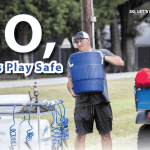Return to play has many facets. Most athletic trainers have a screening process that requires athletes to pass through different phases; from mobility, to strength, to plyometric, to full speed movement. By taking a closer look at when an athlete is ready to return to play, you will find there are many more variables that need to be addressed such as symmetry throughout the body, neuromuscular training, and proximal control training Each of these components are essential to help prevent future injury. Every sport puts different demands on athletes and their bodies therefore, sport-specific exercises need to be incorporated into the strengthening aspect of rehabilitation from the beginning and continued throughout. Not all exercises need to be linear so the movements can carry over to the actual sport.
Take for example a shooting guard who has injured an ankle. His RTP process needs to incorporate what he is going to be asked to do when he does return. A good start may be to have the athlete start by taking a side step, which is a form of change of direction. Then progress to a side step that goes into a deeper lunge and so on. Finally, the last aspect you should consider is the athlete’s mindset and the fear they may have of putting full pressure on the injured area. Not only should you train the injury back to full strength, but also train the athlete’s confidence so that they are ready to perform at the same high level as they did before the injury. The goal for everyone involved in an athlete’s healing process is to see them on the field playing the sport they love. A return to play protocol is essential in helping them achieve this goal and also to help prevent future injury.
Blog information by: Jennifer Smith






